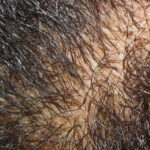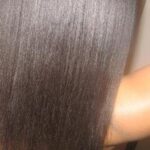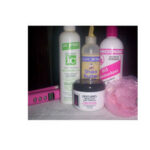Crown area hair breakage can be very distressing, especially when the rest of your hair is flourishing. It can also be frustrating when your hair’s hemline is shaped like a W rather than a healthy U or V because of crown area and middle area breakage issues. Don’t be discouraged! If your crown area breakage is not the result of a medical issue, there is hope for restoring your crown area to its normal fullness and length. The key is to isolate the crown area and pamper it to life. This article will give you 7 quick tips for encouraging hair growth in your crown area again.
How to fix crown area hair breakage:
1.) Investigate. Is your crown area breakage caused by physical trauma?
It is helpful to determine the exact cause of your breakage, especially if it is caused by handling and physical trauma. Often times, mechanical damage is something you are fully aware of- how have you handled your crown air hair in the past? Is your sew-in done too tightly? Have you been rough combing your crown area? Wrapping? Have you been neglecting to fully moisturize the area? Applying too much heat? Did you overlap a relaxer? Have you been rollersetting too tightly? Has repetitive coloring affected your crown? Once you determine a physical cause for your crown area breakage, simply discontinuing the practice will turn your crown around in several weeks.
2.) Diagnose. Is it a protein/moisture balancing issue?
Next, you will need to determine if the breakage can be fixed with either protein or moisture deep conditioning. You’ll need to read my article: The Fine Art of Protein and Moisture Balancing for help with determining your required product solution for your crown area breakage. More than likely, restoring the moisture balance will be your focus. Once you know whether your product focus should be protein or moisture, you’ll need to deep condition weekly with heat to restore your crown area. When you condition your hair, make sure that you section the hair in increments so that each and every section of hair, especially the crown, is treated. You’d be surprised the number of people who simply coat the edges, barely scrunch through the middle, and slather the ends with conditioner product. You have to get in there good and make sure the crown area gets some love!
You also want to be sure to moisturize (either protein or moisture-based) the crown area daily. Part through and really isolate the crown. Really focus your daily moisturizing efforts in the middle. Very few people treat the middle sections of hair to moisturizer on a regular basis.
3.) Massage to stimulate your crown area.
A quick massage is beneficial to your scalp and will help you restore sluggish blood flow to the crown area. A nightly massage lasting about 10 minutes is all you need. You may choose to add stimulating essential oils to your scalp massage for maximum impact. These lightweight oils are great for getting nutrients to the scalp and they have a calming, relaxing effect as well. Good essential oils to try in your massage are peppermint, lavender, rosemary, and thyme oils. Sweet almond oil and jojoba oil are popular carrier oils to combine with your essential oils since too high a concentration of these oils can actually irritate the scalp.
4.) Avoid pulling your nape back into ponytails to help the crown area.
Actually, you’ll want to avoid any styles that place tension on the crown area hair period. Free form styles like braidouts, twistouts, and rollersets* are good for growing back out a crown. Ponytails tend to increase crown area breakage, especially if new growth is present in the crown area or if “phony ponies” are used. Keeping ponytails and buns damp underneath can also weaken the hair and lead to breakage in the middle of the head.
Weaves should be kept to a minimum when you are trying to grow out crown area breakage since the braiding that tends to be done under many weaved styles can also stress the crown area.
*When rollersetting, do take care to carefully place the metal clips in the crown area. Metal clips can get very hot under the dryer and can damage the hair. Avoid clipping rollers together!
5.) Avoid direct heat to the crown area as much as possible.
Heat can make breakage problems a lot worse. Everyone knows to stay away from blow dryers and flatirons, but you should also be careful with hooded dryer heat since the crown area can receive a lot of heat attention under the dryer. The crown area is often the very first section to dry. Make sure that your dryer model circulates heat well and that you are able to adjust your heat settings as needed. Check your crown area regularly. If your crown area dries first, spray it again with water to allow your other areas to catch up. Also give your hair adequate time to dry once it is set so that you can air dry your hair to completion. Once your hair is about 80% dry under the dryer, allow the rest to dry naturally.
6.) Cover your hair in a satin or silk scarf or bonnet nightly.
Avoid cotton bandannas or sleeping on cotton pillows that can zap precious moisture from your hair.
7.) Keep the crown area trimmed and as neat on the ends as possible.
If your hair is layered, you really want to make sure that the ends that are originating from your crown are kept neat. Uneven, splitting or otherwise frazzled hair easily tangles itself and can lead to a cycle of crazy breakage. Hairs should be able to move freely past other hairs without “catching.” This “catching” can lead to breakage in and around the crown area of the head.
I’ve had my share of crown area breakage issues! What I ended up doing was isolating my crown area and trimming it down to a blunt length. It was much shorter than the rest of my hair, but the trim allowed me to focus on the area-to treat it separately and to comb it separately until it improved.
Good luck!





